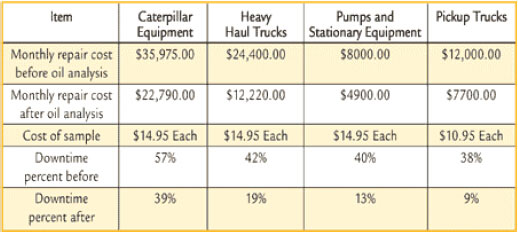Practicing Oil Analysis Magazine. May-June 2005
By Brett Winberg, LubeTrak
First Energy Services is an aggressive oil field construction company operating more than 125 pieces of Caterpillar equipment and more than 400 pickups and trucks serving a majority of oil field needs. Its core business consists of building oil drilling pads, pipeline construction, fabricating wells, pipe cleaning and similar jobs. Robbie Weakland is the company maintenance operations manager and Billy Waite is the lead technician at First Energy Services.
As maintenance specialists in their respective fields, they applied routine lubrication-related practices including 250-hour engine oil drain intervals for all Caterpillar equipment and 10,000-mile intervals for over-the-road trucks. Maintaining the schedule in a geographically distributed operation proved difficult.
Looking for Improvements
Weakland and Waite were interested in reducing the cost of maintaining the large fleet of vehicles and machines. With the assistance from a recognized lubrication specialist, the group determined that some improvement could be achieved through the use of higher performance products. Following much testing and analysis, the consultant determined that the quality of the oils in use was not as high as the company originally believed. With hard work and determined mechanics, all of the equipment and trucks were changed over to the new brand of oil and fewer lubrication-related problems occurred. However, large amounts of money were still being spent on repairs and the desired results were not fully achieved.
The Next Step
Weakland and Waite attended an oil analysis training class just before the final maintenance decision was made to change lubricants, filters and maintenance practices. They were introduced to the concepts of proactive maintenance and condition-based machine monitoring, which the two believed held promise for continued improvements.
To test the concept, they upgraded the oil analysis program with the help of LubeTrak to begin to monitor, track and trend all oil analysis results, including contaminants, lubricant health and machine condition properties. The objective was to establish a base line on all the Caterpillar equipment and identify which units might be problematic for the coming production year.
The next objective was to evaluate pickups and over-the-road trucks. Additionally, the company tested the use of off-line filters on cross-country vehicles to test the prospect of reducing the total required maintenance. Through the analysis program, First Energy found other problems with its engines, transmissions and other components.
The day it began to fall into perspective was when high levels of potassium and positive glycol were reported on a scraper engine oil sample. Taking the lab's advice, mechanics resampled the engine at 100 hours with the same results. The equipment was immediately shut down and inspected to determine the root cause, which was found to be a blown head gasket. The repair bill for the head gasket was $400 and saved a $15,000 engine, thanks to an oil sampling program.
The company has since implemented a program covering all of the equipment, from engines to final drives.
Providing Results
Since implementing the new analysis program, lubricant and maintenance costs have declined. In particular, new oil and filter purchases and disposal costs have been significantly reduced. First Energy Services has also added training programs for mechanics and operators to ensure everyone understands the need for quality and repeatable oil sample collection, and it has installed proper sample ports on the majority of the equipment to ensure that a clean representative sample is collected every time.
Savings from improved lubricant quality and improved oil analysis methods average $32,765 per month at present, as shown in Table 1 which shows the savings after using an oil analysis program.




